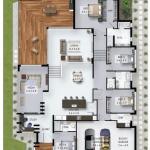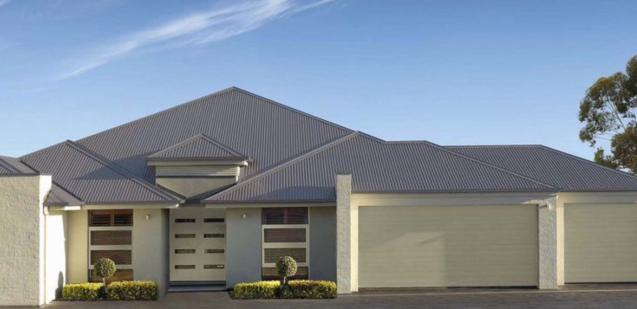
How to Make a Floor Plan Work for Your Block
By HOUSPECT Building and Pest Inspections|June 26, 2018
Whether you like it or not, you can’t just drop your dream home on any block and hope that it works. There are so many factors to consider that it takes multiple different construction professionals working together to make an impactful home design a reality. Most architects will start with a vision but you can bet that 9 out of 10 times the first thing they will look at is the block.
Block Qualities
The slope, orientation, size and any configuration considerations of a block will largely dictate the quality of your build. That is not to say you can’t have the floor plan that you want, it just means that you have to weigh the cost of each block against the cost of constructing a property with the floor plan that you want. It is highly probable that you will be living in your home for a number of years, which means that you will have a long time to regret any compromises that you make in order to squeeze everything into the available space. You may also find it difficult to sell your home if the floor plan just isn’t right for the block.
Some blocks are ideal for open design, whereas others may limit you to buying off the plan. If you intend on taking risks, working with either a design professional or a highly qualified builder is highly recommended. Again, cost is a consideration and you will also want to seek guarantees that the floor plan is achievable before signing any contracts.
Floor Plan Design
Having your floor plan pinned down is incredibly important when allocating space on a block. Leaving out a room that you want or getting measurements wrong will result in a nightmare if the error isn’t caught in time. Keeping a list of rooms and features will be key and will act as a checklist when it comes to creating sketches of the floor plan. It is also important to check measurements with your builder as it’s hard to visualize a space if you have no point of reference.
Your budget should feature heavily during the design phase, as there is no point coming up with a list of grand ideas if the money runs out before your home is even halfway complete. Builders already know how to cost materials on a square meter basis – rely on a trusted builder’s experience to keep you on the right track. Sometimes what you want may be well outside your budget, so prepare a number of different plans so as to avoid disappointment.
Testing the Land
Once everything gets moving, things will start happening fast. What may seem like a reasonable timeframe during the design phase will soon get swallowed up. Negotiating an extension on your settlement before any work begins to give yourself some breathing space can be beneficial. Ideally you should have a land and soil test carried out before you agree to settlement. The quality of soil, topography of features such as trees, rocks and other properties should factor into the decision-making process.
Once you are happy with the block, land quality and design of your home it is time to start building. You should work closely with your builder to ensure that every stage of the build goes according to plan. One of the main ways to help prevent crossed wires or detect any defects during a build is through the use of stage inspections.
As each important phase of the project is completed, an inspection is carried out before work begins on the next phase.
For more information on stage inspections for new builds or extensions, call Houspect in New South Wales today on 1300 258 789.
Block Qualities
The slope, orientation, size and any configuration considerations of a block will largely dictate the quality of your build. That is not to say you can’t have the floor plan that you want, it just means that you have to weigh the cost of each block against the cost of constructing a property with the floor plan that you want. It is highly probable that you will be living in your home for a number of years, which means that you will have a long time to regret any compromises that you make in order to squeeze everything into the available space. You may also find it difficult to sell your home if the floor plan just isn’t right for the block.
Some blocks are ideal for open design, whereas others may limit you to buying off the plan. If you intend on taking risks, working with either a design professional or a highly qualified builder is highly recommended. Again, cost is a consideration and you will also want to seek guarantees that the floor plan is achievable before signing any contracts.
Floor Plan Design
Having your floor plan pinned down is incredibly important when allocating space on a block. Leaving out a room that you want or getting measurements wrong will result in a nightmare if the error isn’t caught in time. Keeping a list of rooms and features will be key and will act as a checklist when it comes to creating sketches of the floor plan. It is also important to check measurements with your builder as it’s hard to visualize a space if you have no point of reference.
Your budget should feature heavily during the design phase, as there is no point coming up with a list of grand ideas if the money runs out before your home is even halfway complete. Builders already know how to cost materials on a square meter basis – rely on a trusted builder’s experience to keep you on the right track. Sometimes what you want may be well outside your budget, so prepare a number of different plans so as to avoid disappointment.
Testing the Land
Once everything gets moving, things will start happening fast. What may seem like a reasonable timeframe during the design phase will soon get swallowed up. Negotiating an extension on your settlement before any work begins to give yourself some breathing space can be beneficial. Ideally you should have a land and soil test carried out before you agree to settlement. The quality of soil, topography of features such as trees, rocks and other properties should factor into the decision-making process.
Once you are happy with the block, land quality and design of your home it is time to start building. You should work closely with your builder to ensure that every stage of the build goes according to plan. One of the main ways to help prevent crossed wires or detect any defects during a build is through the use of stage inspections.
As each important phase of the project is completed, an inspection is carried out before work begins on the next phase.
For more information on stage inspections for new builds or extensions, call Houspect in New South Wales today on 1300 258 789.



